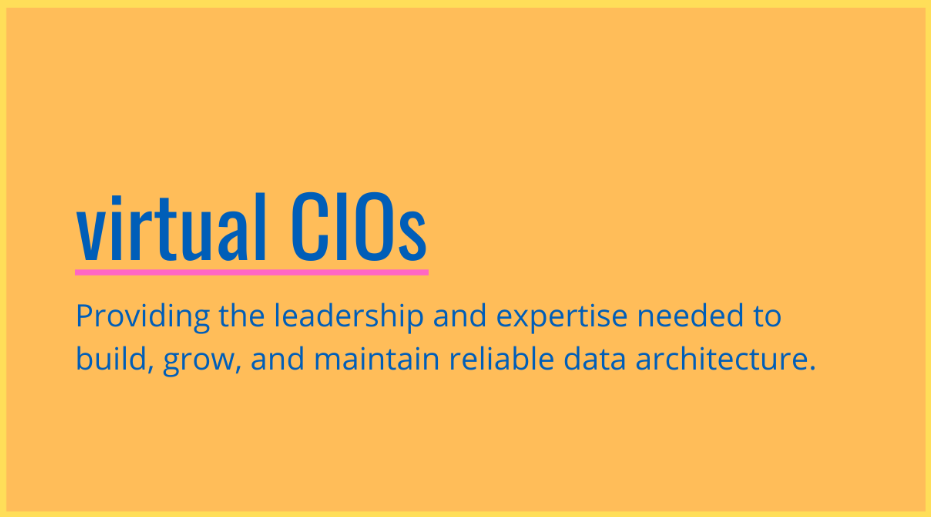Hello, I’m Nate, a vCIO at MIS Solutions, where I offer your organization the benefits of in-house tools and IT support it deserves. With a background as a support tech, then a systems administrator, and now as a virtual chief, I’ve seen firsthand how technology can empower and challenge nonprofit organizations, something a vCIO helps to manage. What are we discussing in today’s post? We’ll dive into the top 10 reasons why a vCIO should be on the 2024 wishlist for your NPO, especially considering that most nonprofit organizations are beginning to utilize this role. Stick with me to get a broader perspective on what I bring to the table where we’ll cover how both existing and emerging technology can and will help your cause. Before we get started on the list, let’s address the basic question here:
Who or what is a vCIO?

A vCIO, aka Virtual Chief Information Officer, is a senior-level IT professional offering contractual CIO services to businesses. This covers a broad range of topics, from developing IT strategy to designing optimal network infrastructure to conducting cybersecurity audits and assessments. The list is long, and depending on the quality of the IT pro, it could be longer than most. The important thing to know is that a vCIO is someone who can help you with the strategy and who can get hands-on with the implementation and management.
Let’s take a look at how a vCIO can be crucial to nonprofits’ business success.
1. Nonprofit Organizations Strategic Technology Planning
A vCIO understands your nonprofit’s technology needs and opportunities and crafts a roadmap that aligns IT with your mission. This foresight, characteristic of a vCIO, ensures that both emerging and current technology investments support your long-term goals, not just the immediate needs. This is especially crucial in the nonprofit sector, where efficient IT operations are important.
Here, a vCIO can provide strategic guidance on leveraging technology to achieve your mission while adhering to strict budget sustainability. Not only does strategic planning help to identify cost-effective solutions and streamline processes, but it also ensures that your organization’s technology infrastructure will check the other important boxes like keeping your data secure and compliant with industry standards (e.g., protecting your volunteers and donors). With budget in mind, we move to number 2 on my list:
2. CIO Budget Management Service
The term nonprofit immediately suggests that typical revenue generation is not the focus of that organization. Yet, said organization must run effectively. For Nonprofits, financial management is of utmost priority, seeing as they often operate under strict budget constraints. A vCIO provides cost-effective solutions for a nonprofit’s attempt at good budget management.
Hiring a vCIO is easier and provides more value for the buck, which helps optimize your IT spending, ensuring you get the most value from your technology investments.
3. Enhanced Cybersecurity for NonProfits
The disruption to business continuity is among the most expensive damage any business can incur, and nothing disrupts business continuity as well as a cyber attack.
The importance of protecting sensitive data cannot be overstated, which is why many large nonprofit organizations utilize in-house vCIOs for this task. A vCIO strengthens your defenses, implements best practices for cybersecurity, and ensures compliance with data protection regulations; key parts of the nonprofit IT include planning and executing these measures. Traditionally, this would be a crucial in-house role within your organization. With a vCIO, you benefit without incurring the full-time cost, bringing support into the organization’s systems.
4. Outsource Disaster Recovery Planning
A vCIO develops and tests disaster recovery plans, ensuring your organization can quickly recover from data loss or other IT disasters, minimizing downtime, and protecting your mission-critical operations.
5. Managed Service Provider Digital Transformation
To stay relevant and effective, embracing digital transformation is crucial. Nonprofit organizations do utilize temporary chief information officers, known as vCIOs if they can’t perform at a C-suite level. As a leader of change management initiatives, a vCIO ensures your organization adopts new technologies that enhance your service delivery, focusing on how emerging technology will help your nonprofit’s overall objectives.
6. MSP Vendor and Tool Management
Navigating the landscape of vendors and IT-related tools can be overwhelming, but a good vCIO can assist with existing and emerging technology that will help your business objectives. A vCIO manages these relationships with MSPs, ensuring you have the best solutions in place and many that they can’t perform or duplicate tools are avoided.
7. Fractional Expertise on Demand
Having access to vCIO services means you have expert advice when you need it, without the cost of a full-time C-suite executive – responsibilities of a vCIO include but aren’t limited to this. This fractional service model is particularly advantageous for nonprofits.
8. Customized IT Support
A vCIO ensures that both specific and general IT support needs are met within your organization and those departments, integrating tools and support into your in-house systems seamlessly. This in-house customization improves efficiency and user satisfaction.
9. Virtual Chief Information Officer Leadership in IT
A good vCIO must be able to lead change management initiatives organization-wide, instilling the widespread buy-in that allows any IT tool or strategy to be successful – aligning such action with nonprofit business objectives.
10. Virtual CIOs Focus on Core Mission
Finally, by outsourcing your IT leadership to a vCIO, your nonprofit can focus on its core mission, not on managing all the IT support needs. The vCIO alleviates the complexity of IT, allowing your team to focus on their primary job: making a difference in the departments of their organization.
Selecting a Nonprofit Virtual CIO
When seeking a vCIO, it’s crucial to choose someone who understands the unique challenges and needs of the nonprofit sector. Look for a provider that understands your technology needs, aligns with your nonprofit organization’s goals, and has proven experience in providing support for the organization.
The Cost of a Nonprofit vCIO Services with MIS Solutions
At MIS Solutions, we understand that nonprofits need clear, straightforward pricing for services, such as help desk support which an effective vCIO would manage. Our vCIO services are designed to be affordable and scalable, providing you with strategic IT leadership without breaking the bank. MIS Solutions provides robust vCIO services that are tailored to the capacity of your organization. With us, you receive more value for each cent spent!

Final Thoughts from an MSP vCIO

For many nonprofit organizations, a vCIO is not just a luxury; it’s an absolute necessity that not only keeps things efficient but provides maximum effectiveness. With the right vCIO, your organization can navigate the complexities of IT, embrace digital transformation, and continue to grow and serve your community effectively.
Remember, technology should empower your mission, not hinder it. A nonprofit vCIO ensures that your technology strategy does just that, enabling your organization to reach new heights. Let’s start this journey together and see how technology can enhance your mission.
If you’re interested in exploring how a vCIO can benefit your nonprofit near you, reach out to us at MIS Solutions. Let’s initiate the transformation of your IT into a strategic asset for your nonprofit mission, using the vCIO as a tool to be successful.


